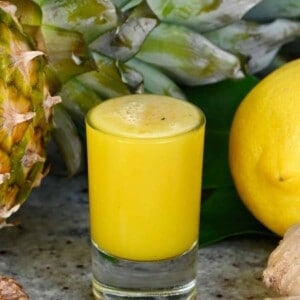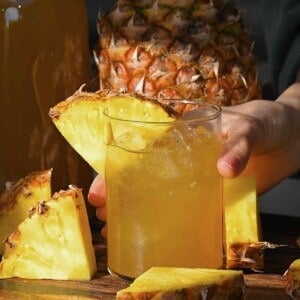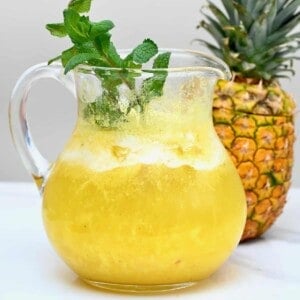This post may contain affiliate links. Please read our disclosure policy.
This pineapple skin tea mixes pineapple peel, ginger, turmeric, and cinnamon for a tasty, anti-inflammatory drink that helps digestion. Sweetened with honey, it’s a perfect health boost!

I love reducing food waste, and this pineapple tea recipe is a favorite! Inspired by a traditional Jamaican drink, it combines pineapple peels, ginger, and orange or lemon juice for a warming and delicious tea.
Plus, this pineapple skin tea is excellent for your health because pineapple, including its peel and core, contains bromelain, a protein-digesting enzyme with anti-inflammatory benefits. Rich in vitamin C, it aids digestion, making this amazing drink perfect for any time of the year.

While it’s refreshing served over ice in the summer, I always make sure to sip on a hot cup of pineapple tea whenever I feel a cold coming on. It’s one of my favorite natural remedies, along with these lemon, ginger and cayenne immunity shots and turmeric ginger energy shots.
Want to save this recipe?
Watch the recipe video tutorial
Ingredients
While there are variations of the tea, here is my favorite ingredient combo. I have carefully chosen these ingredients for their flavor and health benefits.

- Pineapple peel: Use the core, too, for even more bromelain
- Orange and lemon: Make sure to use fresh orange and lemon juice. You can use a regular orange or even blood orange.
- Aromatics: Ginger and turmeric. I prefer to use fresh rather than powdered, so you don’t end up with the ground spice’s sediment in the liquid.
- Spices & Herbs: Cinnamon sticks, cayenne or black pepper (optional, to help curcumin absorption), and rosemary. You can experiment with other herbs that pair well with pineapple, such as mint, lemon basil, basil, sage, etc.
- Sweetener: I sweetened it with honey after making the tea. You could use maple syrup, or not add a sweetener at all.
How to make pineapple skin tea
Clean the pineapple: It’s essential to clean the pineapple skin thoroughly. Scrub the pineapple thoroughly with a vegetable brush. I like to do a vinegar soak (optionally adding salt as well) to help remove bacteria and pesticides from the skin. Fill a large pot with enough water to submerge the pineapple body and add 1-2 Tbsp of vinegar (and optionally 1 Tbsp salt) – this shouldn’t affect the pineapple’s flavor. Allow it to soak for 20-30 minutes, then rinse well with clean water.
Peel the skin: Pat the rinsed pineapple dry and then remove the peel with a sharp paring knife. You can also use the pineapple core. The pineapple flesh can be eaten as a snack or stored in the fridge/freezer to make smoothies.

Simmer the ingredients: Juice the lemon and oranges, then combine all the ingredients (excluding the honey) in a large pot with water. Heat over medium heat until it reaches a boil, then reduce the heat and let it simmer for one hour. The longer it simmers, the more flavorful the tea will become.

Strain: Allow the tea to cool down slightly before you sieve it and transfer it to bottles.

You can add a little sweetener now (I used honey), or just before serving it, or omit this entirely. The pineapple peel tea is then ready to drink immediately or store for later. You can enjoy the anti-inflammatory warm or cold. It can be enjoyed alone or added to other drinks, including lemonade and cocktails, in place of pineapple juice.

Tips for pineapple peel tea
- Make sure to thoroughly wash the pineapple before using the pineapple skin.
- You can collect pineapple scraps in a bag in the freezer until you’re ready to make a batch of this pineapple skin tea.
- Add a pinch of black pepper to each serving of the tea (you won’t taste it). This helps our bodies fully absorb the turmeric nutrients.
- Bromelain, found in the pineapple peel and core, can interact with medications like anticoagulants and antibiotics. Consult a doctor before drinking pineapple tea if you are on any medications.
How to store
- Fridge: I like to keep my pineapple skin tea in a bottle with a tight seal to keep it fresh. You can also use airtight glass containers to store it in the fridge for up to 10 days—just be sure to avoid any staining!
- Freeze: The tea can also be frozen into ice cubes to add to drinks or thaw and consume.

How to use the leftover pulp?
There’s no need to discard the leftover pulp. You can use it in several ways. First, remove the rosemary sprigs and cinnamon sticks. Then:
- Make juice: After brewing the tea, the pineapple pieces should still have plenty of flavor. Add the pulp to a blender with some water and blend. Then, sieve the mixture to make juice.
- Or blend into pulp: Blend the pineapple peel, ginger, and turmeric into a pulpy mush. This can be frozen into ice cubes and then used in smoothies, added to marinades, or made into a single portion of hot tea.

More refreshing pineapple drinks
If you try this pineapple skin tea recipe, let me know how it goes in the comments below. I’d appreciate a recipe card rating and would love to see your recipe recreations – tag me on Instagram @Alphafoodie!

Best Pineapple Skin Tea
Ingredients
- 17 cups water
- 1 pineapple large, the peel and core
- 2 oranges any variety
- 1 lemon
- 2 Tbsp turmeric grated
- 3 Tbsp ginger grated
- 2 sprigs rosemary or thyme, basil, lemon thyme, etc.
- 2 cinnamon sticks
- 1/2 tsp Cayenne pepper or fresh black pepper (for absorbing turmeric nutrients)
- 3 Tbsp honey Optional, can be added in teaspoons when serving the tea; OR maple syrup
Instructions
Prepare the ingredients
- Scrub the pineapple thoroughly with a vegetable brush. Optionally, do a vinegar soak. Fill a large pot with enough water to submerge the pineapple and add 1-2 Tbsp of vinegar (and optionally add 1 Tbsp salt). Soak for 20-30 minutes, then rinse well with clean water.
- Pat the rinsed pineapple dry and then remove the peel with a sharp paring knife. You can also use the pineapple core.
- Juice the lemon and oranges.
Make the tea
- Pour the water into a large pot. Add the pineapple skin, grated ginger and turmeric, lemon and orange juice, rosemary sprigs, cinnamon sticks, and pepper. Bring to a boil over medium heat, then simmer for about 1 hour—the longer it simmers, the more flavorful it will become.
- Let the tea cool slightly, then sieve it and transfer it to clean glass bottles.
- The tea is ready to drink immediately or store for later. Optionally, add a little sweetener now or just before serving. Serve warm or cold.
Video
Notes
Nutrition
Nutrition information is automatically calculated, so should only be used as an approximation.













Nothing against this recipe… another influencer claimed this cured allergies and my husband stopped his allergy med to try it out… been sneezing for days with no relief. May be good for anti inflammatory needs but not allergy
Hi Emmalee,
I appreciate your perspective. While this recipe may have some health benefits, it’s essential to address allergies with appropriate medical guidance.
I don’t have access to fresh turmeric or ginger right now. Can I sub dried and if so how much? I have made a version of this before but I had fresh ginger and turmeric at the time.
Hi Kimberly,
You can omit the turmeric and ginger. If using them in dried powder form, you can use about 0.5-1 Tbsp turmeric powder and about 1 Tbsp ginger powder. Feel free to adjust to taste as well. I hope this helps.
Is it possible to use dried turmeric and ginger? If so, any idea on what the substitution would be? Thanks.
Hi Kelli,
You can omit the ginger and turmeric. If using them in dried powder form, you can use about 0.5-1 Tbsp turmeric powder and about 1 Tbsp ginger powder. Feel free to adjust to taste as well. I hope this helps.
I was impressed by the level of detail and quality of information on this website, truly a valuable resource!
Thanks.
I M reading that pineapple loses the benefits of bromeline at temperatures 160 or greater. Any thoughts on how to make this tea without losing that benefit? I haven’t successfully found a site that shows how to dehydrate and powder to keep bromeline in tact. Any insights welcomed!
Hey Dalene! You’re absolutely right that bromelain, the enzyme in pineapple, starts breaking down at temperatures above 160°F (71°C). Since this tea requires simmering, some of the bromelain will be lost in the process.
If you want to preserve bromelain’s benefits, you could try:
✔️ Cold-infusing the pineapple skins – Instead of boiling, steep them in room-temperature or cold water for several hours or overnight. This won’t extract as many flavors as simmering, but it should help retain the bromelain.
✔️ Adding fresh pineapple juice after brewing – You could make the tea as usual, then stir in some fresh juice once it cools slightly.
✔️ Dehydrating and powdering the skins – I haven’t tested this personally, but you’d likely need a low-temperature dehydrator (under 160°F) and then grind the dried skins into powder.
If you try any of these methods, I’d love to hear how they work for you!
I’m on my second batch of this wonderful tea! I suffer from wheezing in the sinuses which is so loud at night it keeps me awake. Not anymore! A couple of mouthfuls of this tea before bed and no sinus issues, thank you! I’m also going to make a quercetin tea from lemon and grapefruit peel which is a powerhouse that assists the body absorb zinc: so the perfect remedy if you feel a cold or flu coming on. I will now be securely armed against viral infections with these wonderful safe and effective remedies. A big plus for me in the news today in Queensland, Australia is that we are about to experience an enormous glut of pineapples, due to a once in 30 years ‘mass flowering’ event. I’m stoked and my freezer will be replete with delicious pineapples and pineapple tea. Thankyou again for sharing this brilliant remedy.
Thank you so much for your comment. So happy to hear you liked the recipe. This is so exciting having all these pineapples – enjoy!
I’d read somewhere about using the pineapple skin to make tea and stumbled upon your recipe. SO FRIGGIN GOOD!! I will be making this for years to come! Thank you for sharing!!
So happy you’ll give this a try <3
Can this tea lower my sugar levels???
Can someone comment on this?
Thanks
Hi Sonia,
It’s best to consult with your medical professional if you are worried about sugar levels. After all, this tea does contain fruit and honey in it.
I am very happy to have taken the time to read your recipe. Generally I don’t like too, nor trust many. But this one sounds trustworthy from my perspective and previous research. Thank you for the good work.
Thank you so much for your comment, Rebecca. I hope you give it a try 🙂
Although these are delightful ingredients, and I’m sure the tea is tasty , there is one huge drawback here: if you heat pineapple, its peels or core, you will destroy the Bromelain and its benefits. According to my college food science professor, heat destroys enzymes.
If you want those great benefits, you’ll have to ferment it, (tepache) or make a raw, infused beverage. You can cook the turmeric and spices and combine them afterwards, but if you heat it, adios, Bromelain. 🙁
Thank you for your comment. If you prefer, you can try this tepache recipe, also available here on the blog: https://www.alphafoodie.com/tepache-de-pina/
Hi there 🙂 I am so so glad did you put the black pepper and there and why. A lot of people do not do that. I love this tea and I actually add dried hibiscus leaves when I’m cooking it and cloves and fresh rosemary and sometimes some other odds and ends I have around. Thank you for your Recipes. Blessings
Thank you so much for your comment, Susan 🙂 Adding dried hibiscus sounds delicious!